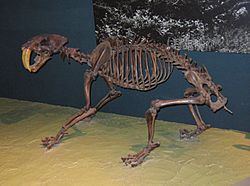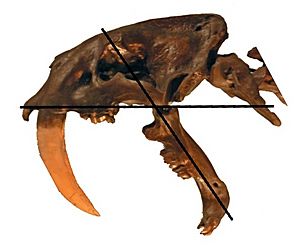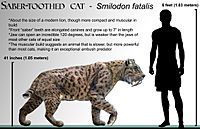Smilodon facts for kids
Quick facts for kids SmilodonTemporal range: Pleistocene
|
|
|---|---|
 |
|
| Smilodon fatalis skeleton: National Museum of Natural History, Washington DC. |
|
| Scientific classification | |
| Kingdom: |
Animalia
|
| Class: | |
| Order: | |
| Family: | |
| Subfamily: | |
| Genus: |
†Smilodon
Lund, 1842
|
| Species | |
|
†Smilodon fatalis; |
|
Smilodon was a type of saber-toothed cat. These amazing big cats lived a long time ago. There were three main kinds, or species, of Smilodon.
The oldest and smallest species was Smilodon gracilis. It lived from about 2.5 million to 500,000 years ago.
Smilodon populator was a very large and heavy species. It lived in eastern South America from about 1 million to 10,000 years ago. This huge cat stood about 1.2 meters (4 feet) tall at the shoulder. It was about 2.1 meters (7 feet) long. It weighed between 220 and 400 kilograms (485 to 880 pounds). This made it one of the heaviest big cats ever! Its top canine teeth were very long, reaching up to 28 centimeters (11 inches). They stuck out about 17 centimeters (6.7 inches) from its upper jaw.
The most famous species was Smilodon fatalis. It lived from about 1.6 million to 10,000 years ago. Many bones of this cat have been found at the Rancho La Brea tar pits in Los Angeles. The sticky tar there has preserved about a million bones from animals that lived during the late Pleistocene Ice Age. About 162,000 of these bones are from Smilodon, which means about 1,200 individual cats. Smilodon fatalis was about the size of a female lion, but it weighed more, around 200 kilograms (440 pounds). It stood about 1 meter (3.3 feet) tall at the shoulders.
Contents
Teeth and Jaws

Smilodon is most famous for its incredibly long canine teeth. These were the longest teeth found in any saber-toothed cat. In the largest species, Smilodon populator, they could be about 28 cm (11 in) long. The teeth of S. fatalis grew very fast, about 7 millimeters (0.27 inches) per month. They reached their full size in about 18 months.
These long canine teeth were thin and had small saw-like edges. They were also quite fragile. This means they could not have bitten into hard bone. So, Smilodon did not use its long teeth to bring down its prey. Instead, it used them only after its prey was already held down.
How Smilodon Hunted
The front legs of Smilodon were longer and much stronger than those of modern cats. This, along with its unique teeth, tells us that it hunted differently. Scientists believe Smilodon was an ambush predator. This means it would hide and then suddenly attack its prey.
It likely jumped onto the neck of its prey. Then, it would use its powerful front legs to hold on tight. Once the prey was held down, Smilodon would slash at the underside of its throat with its long teeth. This is different from how a modern lion hunts. Lions often hunt in groups and use their strong jaws to clamp down on the prey's nose and mouth. The prey then dies from suffocation.
Smilodon could open its mouth incredibly wide, almost 120 degrees! A modern lion can only open its mouth about 65 degrees. This wide gape allowed Smilodon to use its long teeth to slash its victims' throats without having to close its jaws in a full bite.
Smilodon's hunting style was more like a leopard's. Leopards are also ambush predators. Both Smilodon and leopards needed places to hide to get close to their prey. Smilodon had relatively short legs and a short, bobbed tail. Its front legs were especially powerful. Its body was built for springing onto prey, but it was not a very fast runner.
Animals and Plants in Smilodon's World
During the last ice age, many different animals lived in the area where the La Brea Tar Pits are now. These animals would have been possible prey for Smilodon. Some of them included mammoths, bison, horses, camels, ground sloths, pronghorns, tapirs, and deer (like elk). Most of these large animals died out between 5,000 and 10,000 years ago. Scientists think that big climate change and human hunting were the main reasons they disappeared.
There were also many different plants growing at that time. Plants like Juniper, oaks, ragweeds, cedars, redwoods, sagebrush, sycamore, thistle, and walnut grew in the areas where Smilodon lived. Smilodon was able to survive as long as there was enough vegetation to support its prey animals.
Images for kids
-
S. populator skull and a syntype canine from Lund's collection, Zoological Museum, Copenhagen
-
An 1869 lithograph of the holotype molar and maxilla fragment of S. fatalis
-
S. populator canine tooth; the tip points to the right
-
S. populator restored with a plain coat, by Charles R. Knight, 1903
-
S. fatalis fighting dire wolves over a Columbian mammoth carcass in the La Brea Tar Pits, by Robert Bruce Horsfall, 1913
-
Maximum gape of a saber-toothed cat (A) and how it might have bitten the necks of different sized prey (B, C)
-
Mounted skeletons of S. fatalis and a dire wolf near a stuck Paramylodon
-
Lion pride attacking an African buffalo in Tanzania; Smilodon may also have hunted in groups
-
Undersides of S. fatalis skulls, showing canine replacement in the left individual, George C. Page Museum
-
S. fatalis in a climbing pose, North American Museum of Ancient Life
-
Skeletons of S. fatalis (left) and the American lion, two large North American felids which became extinct during the Late Pleistocene, George C. Page Museum
See also
 In Spanish: Smilodon para niños
In Spanish: Smilodon para niños
















